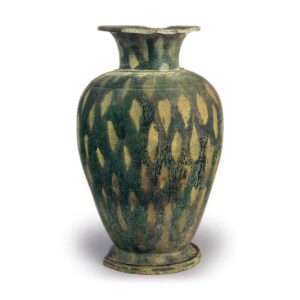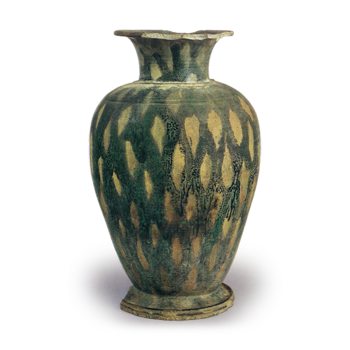
8th century Height 41.7cm, mouth diameter 18.5cm, body diameter 25.7cm, bottom diameter 17.6cm Shosoin
This large green-and-white Nisai vase is formed by joining six sections of the body and eight sections of the neck and base, and has a single protruding band at the joint between the neck and shoulder. There are two sunken lines on the neck and three on the shoulder, and the base is unusually double-layered in both size and shape. This type of vessel was not found in Japanese vessels of the time, and the shoulder strips and the double-layered base are similar to those of Tang dynasty Sansai water jars and white porcelain jars, suggesting that this vessel was made under the influence of Tang dynasty ceramics. The glaze pattern is painted in a diagonal lattice pattern with green glaze, and the space is filled with white glaze. The glaze was not melted well throughout, especially the green glaze was very dark, and the black sesame-like unevenness of the glaze and small circular holes called “nie” were conspicuous. A fragment of a green-and-white Nisai vase, only 1 cm lower in height and exactly the same in form and design, was excavated from the Heijo Palace site. Judging from the glaze tone of the clay, it is thought that they were made at the same time.
8th century
Height 41.7cm, mouth diameter 18.5cm, body diameter 25.7cm, bottom diameter 17.6cm
Shosoin
This large green-and-white Nisai vase is formed by joining six sections of the body and eight sections of the neck and base, and has a single protruding band at the joint between the neck and shoulder.
There are two sunken lines on the neck and three on the shoulder, and the base is unusually double-layered in both size and shape. This type of vessel was not found in Japanese vessels of the time, and the shoulder strips and the double-layered base are similar to those of Tang dynasty Sansai water jars and white porcelain jars, suggesting that this vessel was made under the influence of Tang dynasty ceramics. The glaze pattern is painted in a diagonal lattice pattern with green glaze, and the space is filled with white glaze. The glaze was not melted well throughout, especially the green glaze was very dark, and the black sesame-like unevenness of the glaze and small circular holes called “nie” were conspicuous.
A fragment of a green-and-white Nisai vase, only 1 cm lower in height and exactly the same in form and design, was excavated from the Heijo Palace site. Judging from the glaze tone of the clay, it is thought that they were made at the same time.



